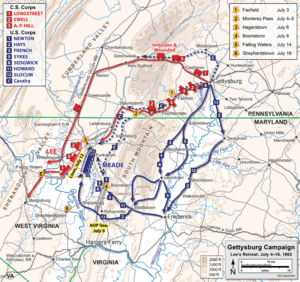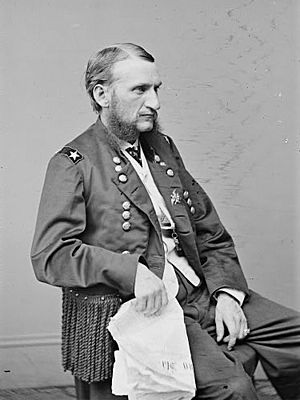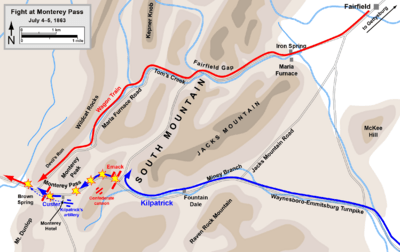Fight at Monterey Pass facts for kids
Quick facts for kids Fight at Monterey Pass (Gap) |
|||||||
|---|---|---|---|---|---|---|---|
| Part of the American Civil War | |||||||
 Retreat from the Battle of Gettysburg |
|||||||
|
|||||||
| Belligerents | |||||||
| Commanders and leaders | |||||||
| Judson Kilpatrick | William E. "Grumble" Jones Beverly H. Robertson |
||||||
| Strength | |||||||
| 4,500 | wagon train, cavalry escort | ||||||
| Casualties and losses | |||||||
| 43 (5 killed, 10 wounded, 28 missing) | 1,300 captured | ||||||
The Fight at Monterey Pass was a small but important battle during the American Civil War. It happened on the evening of July 4, 1863. This fight was part of the Retreat from Gettysburg, when the Confederate army was leaving Pennsylvania. Union cavalry, led by General H. Judson Kilpatrick, attacked a long line of Confederate wagons. These wagons were carrying supplies and wounded soldiers. Even though a small group of Confederate soldiers tried to stop them, the Union cavalry captured many prisoners and destroyed many wagons.
Contents
Why the Fight Happened: Retreat from Gettysburg
After losing the Battle of Gettysburg on July 3, 1863, Confederate General Robert E. Lee knew his army had to leave. He needed to get his soldiers and supplies back to Virginia. Lee realized he couldn't get more supplies in Pennsylvania. Also, the Union army could easily get more soldiers, but he couldn't.
Lee's main concern was moving his many wagons. These wagons carried supplies and wounded soldiers. He sent most of them on a longer route through Chambersburg. But for his main army, he chose a shorter path. This path went southwest through Fairfield and over Monterey Pass to Hagerstown.
On the night of July 4, Lee's army began its retreat. They moved in the dark, which gave them a head start. The route through Monterey Pass was much shorter than any route the Union army could take.
However, some Confederate wagons had already started moving earlier. General Richard S. Ewell had sent his corps' wagons ahead. He split them into three groups. One group went through Monterey Pass. These wagons followed the path of George Pickett's division. Pickett's soldiers were guarding Union prisoners of war.

On July 4, Union General George Meade sent his cavalry to chase Lee's army. Their job was to "harass and annoy" the Confederates as they retreated. General Judson Kilpatrick's cavalry division was ordered to find and destroy a "heavy train of wagons." A Union signal station had seen these wagons. Kilpatrick thought these were Lee's main supply wagons. So, he moved quickly towards Monterey Pass.
Confederate cavalry leader J.E.B. Stuart knew how important it was to protect the mountain passes. He gave this job to Generals Beverly H. Robertson and William E. "Grumble" Jones. Jones understood that Ewell's huge wagon train was in danger in the narrow Monterey Pass. He asked Stuart for his whole brigade to defend it. Stuart gave him two cavalry regiments and some artillery.
The Fight in the Pass Begins
Union General George A. Custer, who was under Kilpatrick, learned about the wagons. A local person told him the wagons were near Monterey Springs, at the top of the Pass. Kilpatrick ordered his troops to move forward, even though he knew there was Confederate artillery ahead. A single Confederate cannon fired one shot, but the gunners quickly left.
The remaining Confederate force was small. It included 20 dismounted cavalrymen and one cannon. They were led by Captain George M. Emack. As Union soldiers approached, the cannon fired. Eight of Emack's men then charged the Union column on horseback. It was dark and raining heavily. The Union cavalry was surprised and many panicked. The Confederates then got off their horses and hid on both sides of the road. When the Union soldiers came back, Emack's men waited until they were very close. Then they opened fire. The Union cavalry thought they were fighting a much larger force. This delay gave Ewell's wagons time to move away.
When General Grumble Jones finally reached the scene, the small Maryland group had been pushed back. Less than half of the wagon train had made it safely through the Pass. Jones promised more soldiers. Emack told his men to hold their ground and save their bullets. Meanwhile, some of Jones's cavalry attacked Kilpatrick's column from behind.
Kilpatrick brought up two cannons and more soldiers. South of the hotel, a bridge was still intact. Colonel Russell A. Alger asked for more soldiers to charge across the bridge. Kilpatrick ordered Custer to attack with his whole Michigan Brigade. The darkness, tough ground, and thick bushes slowed their advance. The small group of Confederates had held up the Union army for almost five hours.
Around 3 a.m. on July 5, Kilpatrick sent in the 1st West Virginia Cavalry. Major Charles E. Capehart led 640 soldiers. They charged what they thought were "five times" their number. In close-up fighting with swords and revolvers, they captured the Confederate cannon. Capehart later received the Medal of Honor for his bravery. The road was now open to attack the wagon train.
Attacking the Wagon Train
The Union cavalry crashed into the wagons, which were now barely protected. Custer was even thrown from his horse and almost captured. Grumble Jones also barely escaped being caught. Union cannons started firing at the wagons, breaking them apart and blocking any escape. Union and Confederate soldiers got mixed up among the wagons in the dark. It was hard to tell who was who. Some Union soldiers even accidentally fired at their own side.
Union soldiers rode all the way through the wagon train. They reached Ewell's infantry and captured many prisoners. Then they rode back to do it again. They quickly built barricades to protect what they had captured. More than 1,300 Confederates were captured. Most of these were wounded men in ambulances. There were also enslaved people, free Black people, and some cavalrymen. Most of the wagons were destroyed. Many of the mules survived and were given to the Union army. Kilpatrick later said he had destroyed Ewell's entire wagon train. But he had only found a small part of the full 40-mile-long train. The Confederates lost about 250 wagons and ambulances.
What Happened Next
After the fight at Monterey Pass, Kilpatrick's division reached Smithsburg around 2 p.m. on July 5. General Stuart arrived with more Confederate cavalry. A cannon fight between the cavalry units caused some damage to the town. Kilpatrick pulled back at dark to protect his prisoners and supplies. He arrived at Boonsboro before midnight.
Lee's retreat continued towards the Potomac River. There were other small fights, mostly involving cavalry. These happened at Hagerstown, Boonsboro, Funkstown, and around Williamsport and Falling Waters. When the Confederates reached the Potomac, they found the water was too high. Also, the bridges they needed were destroyed. So, they built strong defenses and waited for the Union army to arrive. But before the Union army could attack, Lee's army escaped across the river using shallow spots and a quickly rebuilt bridge.
In Popular Media
A 40-minute movie about the battle was released in 2011. It is called Ten Days and Still They Come — The Battle at Monterey Pass.
See also
 In Spanish: Combate en Monterey Pass para niños
In Spanish: Combate en Monterey Pass para niños



